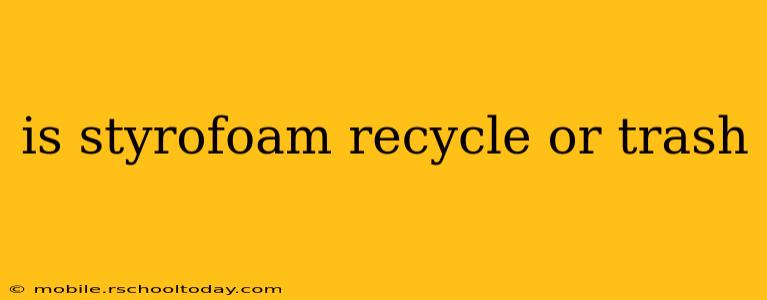Styrofoam, that ubiquitous white packing material, is a source of constant confusion. Is it recyclable? Is it trash? The answer, unfortunately, isn't a simple yes or no. The recyclability of styrofoam depends heavily on your location and the availability of specialized recycling programs. This guide will delve into the complexities surrounding styrofoam disposal and recycling, providing you with the information you need to make informed choices.
What is Styrofoam Made Of?
Understanding the material composition of Styrofoam is crucial to understanding its recycling challenges. Styrofoam, also known as expanded polystyrene (EPS), is a type of plastic. It's created by injecting gas into polystyrene beads, causing them to expand and form the lightweight, rigid foam we're all familiar with. This structure makes it exceptionally buoyant and an effective insulator, but also difficult to recycle using standard plastic recycling processes.
Can You Recycle Styrofoam?
The short answer is: sometimes. Most curbside recycling programs do not accept Styrofoam. Standard recycling facilities lack the equipment and processes needed to effectively recycle expanded polystyrene. The material is lightweight and easily contaminates other recyclables. However, some specialized recycling programs do exist. These programs often require you to drop off your styrofoam at designated locations, rather than including it in your curbside bin.
Where Can I Recycle Styrofoam?
Locating a Styrofoam recycling program requires a bit of research. Start by checking your local municipality's website for information on recycling programs. You can also search online for "Styrofoam recycling near me" or contact your waste management provider directly. Some large retailers, like some grocery chains, may also have Styrofoam recycling initiatives in place.
What are the challenges in recycling Styrofoam?
Recycling Styrofoam presents significant logistical and economic hurdles:
- Contamination: Styrofoam is easily contaminated by other materials, rendering the recycling process ineffective.
- Low Density: Its low density means large volumes of Styrofoam are required to produce a small amount of recycled material. This makes transportation costly.
- Specialized Processing: Recycling Styrofoam requires specialized equipment and techniques that are not widely available.
- Economic Viability: The cost of processing and recycling Styrofoam often exceeds the value of the recycled product.
What Happens if You Throw Styrofoam in the Trash?
Disposing of Styrofoam in the trash sends it to landfills. Because it doesn't readily decompose, it contributes to landfill space issues and environmental concerns. Styrofoam's persistence in the environment is a significant problem, leading to pollution and wildlife harm.
What are the Alternatives to Styrofoam?
Several eco-friendly alternatives to Styrofoam exist. These materials are often made from biodegradable or recycled materials and are less harmful to the environment. These options include:
- Paper-based packaging: Offers a sustainable alternative in many instances.
- Bioplastics: These plastics are created from renewable resources and are biodegradable.
- Mushroom Packaging: A rapidly growing and sustainable alternative.
How to Reduce Styrofoam Use
The best approach to dealing with Styrofoam is to reduce its use whenever possible. Here's how:
- Choose products with alternative packaging: Look for products packaged in materials other than Styrofoam.
- Reuse Styrofoam containers: If you have Styrofoam containers, find ways to reuse them before discarding them.
- Support businesses that use sustainable packaging: Vote with your wallet by supporting companies committed to environmental responsibility.
Is there a difference between Styrofoam and other types of polystyrene?
Yes, there is. The term "Styrofoam" is often used generically, but it actually refers to a specific brand of expanded polystyrene (EPS). There are other types of polystyrene, such as extruded polystyrene (XPS), which may have different recycling options. Always check with your local recycling program for specific guidelines.
In conclusion, while recycling Styrofoam is challenging, it's not impossible. By understanding the limitations of standard recycling programs and actively seeking out specialized options, you can contribute to reducing the environmental impact of this pervasive material. Reducing consumption and choosing eco-friendly alternatives are equally important steps toward creating a more sustainable future.
